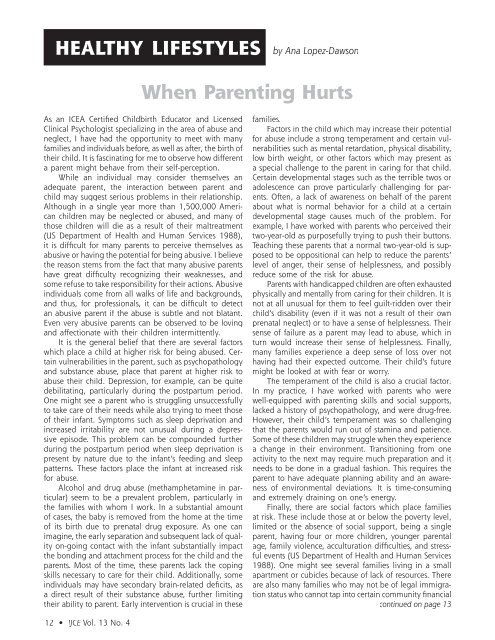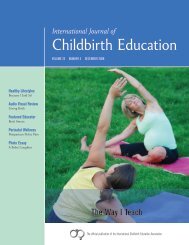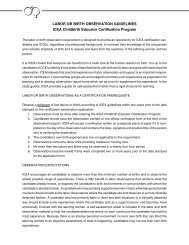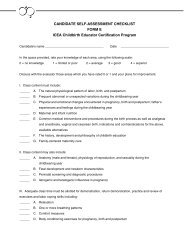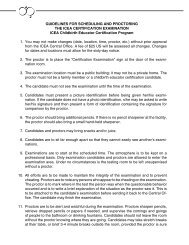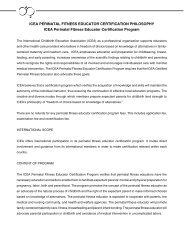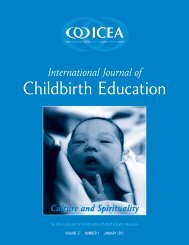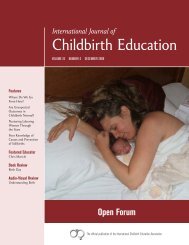JOURNAL - International Childbirth Education Association
JOURNAL - International Childbirth Education Association
JOURNAL - International Childbirth Education Association
You also want an ePaper? Increase the reach of your titles
YUMPU automatically turns print PDFs into web optimized ePapers that Google loves.
HEALTHY LIFESTYLES<br />
by Ana Lopez-Dawson<br />
When Parenting Hurts<br />
As an ICEA Certified <strong>Childbirth</strong> Educator and Licensed<br />
Clinical Psychologist specializing in the area of abuse and<br />
neglect, I have had the opportunity to meet with many<br />
families and individuals before, as well as after, the birth of<br />
their child. It is fascinating for me to observe how different<br />
a parent might behave from their self- perception.<br />
While an individual may consider themselves an<br />
adequate parent, the interaction between parent and<br />
child may suggest serious problems in their relationship.<br />
Although in a single year more than 1,500,000 American<br />
children may be neglected or abused, and many of<br />
those children will die as a result of their maltreatment<br />
(US Department of Health and Human Services 1988),<br />
it is difficult for many parents to perceive themselves as<br />
abusive or having the potential for being abusive. I believe<br />
the reason stems from the fact that many abusive parents<br />
have great difficulty recognizing their weaknesses, and<br />
some refuse to take responsibility for their actions. Abusive<br />
individuals come from all walks of life and backgrounds,<br />
and thus, for professionals, it can be difficult to detect<br />
an abusive parent if the abuse is subtle and not blatant.<br />
Even very abusive parents can be observed to be loving<br />
and affectionate with their children intermittently.<br />
It is the general belief that there are several factors<br />
which place a child at higher risk for being abused. Certain<br />
vulnerabilities in the parent, such as psychopathology<br />
and substance abuse, place that parent at higher risk to<br />
abuse their child. Depression, for example, can be quite<br />
debilitating, particularly during the postpartum period.<br />
One might see a parent who is struggling unsuccessfully<br />
to take care of their needs while also trying to meet those<br />
of their infant. Symptoms such as sleep deprivation and<br />
increased irritability are not unusual during a depressive<br />
episode. This problem can be compounded further<br />
during the postpartum period when sleep deprivation is<br />
present by nature due to the infant’s feeding and sleep<br />
patterns. These factors place the infant at increased risk<br />
for abuse.<br />
Alcohol and drug abuse (methamphetamine in particular)<br />
seem to be a prevalent problem, particularly in<br />
the families with whom I work. In a substantial amount<br />
of cases, the baby is removed from the home at the time<br />
of its birth due to prenatal drug exposure. As one can<br />
imagine, the early separation and subsequent lack of quality<br />
on-going contact with the infant substantially impact<br />
the bonding and attachment process for the child and the<br />
parents. Most of the time, these parents lack the coping<br />
skills necessary to care for their child. Additionally, some<br />
individuals may have secondary brain-related deficits, as<br />
a direct result of their substance abuse, further limiting<br />
their ability to parent. Early intervention is crucial in these<br />
families.<br />
Factors in the child which may increase their potential<br />
for abuse include a strong temperament and certain vulnerabilities<br />
such as mental retardation, physical disability,<br />
low birth weight, or other factors which may present as<br />
a special challenge to the parent in caring for that child.<br />
Certain developmental stages such as the terrible twos or<br />
adolescence can prove particularly challenging for parents.<br />
Often, a lack of awareness on behalf of the parent<br />
about what is normal behavior for a child at a certain<br />
developmental stage causes much of the problem. For<br />
example, I have worked with parents who perceived their<br />
two-year-old as purposefully trying to push their buttons.<br />
Teaching these parents that a normal two-year-old is supposed<br />
to be oppositional can help to reduce the parents’<br />
level of anger, their sense of helplessness, and possibly<br />
reduce some of the risk for abuse.<br />
Parents with handicapped children are often exhausted<br />
physically and mentally from caring for their children. It is<br />
not at all unusual for them to feel guilt-ridden over their<br />
child’s disability (even if it was not a result of their own<br />
prenatal neglect) or to have a sense of helplessness. Their<br />
sense of failure as a parent may lead to abuse, which in<br />
turn would increase their sense of helplessness. Finally,<br />
many families experience a deep sense of loss over not<br />
having had their expected outcome. Their child’s future<br />
might be looked at with fear or worry.<br />
The temperament of the child is also a crucial factor.<br />
In my practice, I have worked with parents who were<br />
well-equipped with parenting skills and social supports,<br />
lacked a history of psychopathology, and were drug-free.<br />
However, their child’s temperament was so challenging<br />
that the parents would run out of stamina and patience.<br />
Some of these children may struggle when they experience<br />
a change in their environment. Transitioning from one<br />
activity to the next may require much preparation and it<br />
needs to be done in a gradual fashion. This requires the<br />
parent to have adequate planning ability and an awareness<br />
of environmental deviations. It is time-consuming<br />
and extremely draining on one’s energy.<br />
Finally, there are social factors which place families<br />
at risk. These include those at or below the poverty level,<br />
limited or the absence of social support, being a single<br />
parent, having four or more children, younger parental<br />
age, family violence, acculturation difficulties, and stressful<br />
events (US Department of Health and Human Services<br />
1988). One might see several families living in a small<br />
apartment or cubicles because of lack of resources. There<br />
are also many families who may not be of legal immigration<br />
status who cannot tap into certain community financial<br />
continued on page 13<br />
12 • IJCE Vol. 13 No. 4


